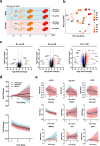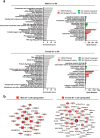Short-term response of primary human meniscus cells to simulated microgravity
- PMID: 38907358
- PMCID: PMC11191296
- DOI: 10.1186/s12964-024-01684-w
Short-term response of primary human meniscus cells to simulated microgravity
Abstract
Background: Mechanical unloading of the knee articular cartilage results in cartilage matrix atrophy, signifying the osteoarthritic-inductive potential of mechanical unloading. In contrast, mechanical loading stimulates cartilage matrix production. However, little is known about the response of meniscal fibrocartilage, a major mechanical load-bearing tissue of the knee joint, and its functional matrix-forming fibrochondrocytes to mechanical unloading events.
Methods: In this study, primary meniscus fibrochondrocytes isolated from the inner avascular region of human menisci from both male and female donors were seeded into porous collagen scaffolds to generate 3D meniscus models. These models were subjected to both normal gravity and mechanical unloading via simulated microgravity (SMG) for 7 days, with samples collected at various time points during the culture.
Results: RNA sequencing unveiled significant transcriptome changes during the 7-day SMG culture, including the notable upregulation of key osteoarthritis markers such as COL10A1, MMP13, and SPP1, along with pathways related to inflammation and calcification. Crucially, sex-specific variations in transcriptional responses were observed. Meniscus models derived from female donors exhibited heightened cell proliferation activities, with the JUN protein involved in several potentially osteoarthritis-related signaling pathways. In contrast, meniscus models from male donors primarily regulated extracellular matrix components and matrix remodeling enzymes.
Conclusion: These findings advance our understanding of sex disparities in knee osteoarthritis by developing a novel in vitro model using cell-seeded meniscus constructs and simulated microgravity, revealing significant sex-specific molecular mechanisms and therapeutic targets.
Keywords: Knee osteoarthritis; Primary cells; RNA-seq; Sex characteristics; Tissue engineering; Weightlessness simulation.
© 2024. The Author(s).
Conflict of interest statement
The authors declare no competing interests.
Figures




References
Publication types
MeSH terms
Associated data
- Actions
Grants and funding
- Graduate Studentship/Women and Children's Health Research Institute
- UOFAB WCHRIIG 3126 Adesida/Women and Children's Health Research Institute
- UOFAB WCHRIIG 3126 Adesida/Women and Children's Health Research Institute
- CSA FAST 21FAALBA04/Canadian Space Agency
- CSA FAST 21FAALBA04/Canadian Space Agency
- CSA FAST 21FAALBA04/Canadian Space Agency
- CSA FAST 21FAALBA04/Canadian Space Agency
- CSA FAST 21FAALBA04/Canadian Space Agency
- NSERC RGPIN-2018-06290 Adesida/Natural Sciences and Engineering Research Council of Canada
- NSERC RGPIN-2018-06290 Adesida/Natural Sciences and Engineering Research Council of Canada
- NSERC RGPIN-2018-06290 Adesida/Natural Sciences and Engineering Research Council of Canada
- NSERC RGPIN-2018-06290 Adesida/Natural Sciences and Engineering Research Council of Canada
- RES00045921 Adesida/University Hospital Foundation
LinkOut - more resources
Full Text Sources
Molecular Biology Databases
Research Materials
Miscellaneous

